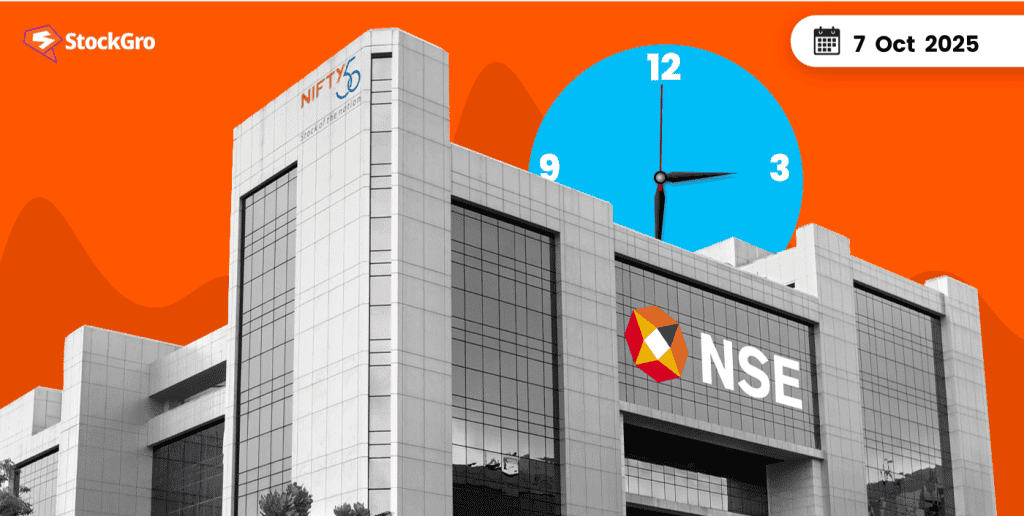
The BSE Sensex gained 136 points (0.17%) to close at 81,926, while the NSE Nifty50 rose 30.65 points (0.12%) to end at 25,108.3.
In the broader markets, the Nifty Midcap 100 climbed 0.47% and the Nifty Smallcap 100 edged up 0.31%, reflecting continued interest in mid- and small-cap stocks despite sectoral divergence.
You may also like: Telecom Sector report and expert insights in detail
Impact on the stock market
Sector-wise performance
The Nifty Realty index emerged as the day’s top performer, rising 1.09%, followed by Oil & Gas, Pharma, Consumer Durables, Healthcare, Bank, Auto, and Energy indices.
However, weakness persisted in FMCG, PSU Bank, Media, Metal, and IT sectors — each closing in negative territory.
The sector rotation reflected investor preference for value buying in cyclical plays while defensive sectors like FMCG and IT saw profit booking ahead of earnings season.
| Sector/Index | Performance |
| IT & BPM sector | -0.04% |
| Healthcare sector | 0.25% |
| Oil & Gas sector | 0.49% |
| Real estate sector | 1.09% |
| PSU Bank in India | -0.41% |
Top gainers today
| Company | Share Price (in ₹) | Change % |
| Bharti Airtel | 1,929.00 | 1.36 |
| Bajaj Auto | 8,904.00 | 1.27 |
| Jio Financial | 309.90 | 1.19 |
| Eicher Motors | 6,957.00 | 1.12 |
| HCL Tech | 1,433.40 | 1.11 |
Top losers today
| Company | Share Price (in ₹) | Change % |
| Axis Bank | 1,186.80 | -2.14 |
| Taa Motors | 698.05 | -2.05 |
| TATA Cons. Prod | 1,120.00 | -1.94 |
| Trent | 4,686.00 | -1.91 |
| Adani Enterprises | 2,542.20 | -1.22 |
Market aftermath: Impact on stocks
FMCG stocks lose flavour for the second straight session
The Nifty FMCG index slipped 0.53% to 54,763.85, marking its second consecutive day of decline, with a cumulative fall of over 0.7% in two sessions.
Major losers included Britannia Industries and Tata Consumer Products (both down nearly 2%), while Emami, United Spirits, and Dabur also shed over 1%. Even big names like Nestle, HUL, ITC, and Marico couldn’t escape the selling pressure.
Brokerage Elara Capital attributed the weakness to the extended monsoon and GST transition, which temporarily disrupted trade channels. Their note also flagged higher input costs as a margin risk for Q2 earnings.
Interestingly, the report added that the recent GST rationalisation — bringing many FMCG items down to 5% from 12–18% — could boost consumer demand in the medium term, even if near-term volumes remain sluggish as pre-GST inventory gets cleared.
Among bright spots, Radico Khaitan rose over 1%, supported by resilience in the liquor segment, while Colgate Palmolive and Varun Beverages closed marginally higher.
Also read: FMCG sector report and expert insights in detail
IT sector braces for another muted quarter
India’s IT industry looks set for another slow quarter. Brokerages including Motilal Oswal and Citi Research expect revenue growth around 6% YoY and profit growth near 5.5% for the September quarter — extending the streak of eight consecutive quarters of single-digit growth.
Global cues remain weak. Accenture recently guided for FY26 revenue below expectations, citing no meaningful improvement in client demand. The macro slowdown in the US, rising tariffs, and policy uncertainty are keeping big clients cautious about new tech spending.
For specific players:
- TCS is expected to post ~2% YoY revenue growth, compared with 8% a year ago.
- Infosys and HCLTech are projected to deliver 8–9.5% growth.
Adding to concerns, a proposed $100,000 H-1B visa fee and 25% US tax on outsourcing have raised questions about future delivery models.
Foreign investors have already offloaded ₹678.36 billion ($7.6 billion) worth of IT stocks in 2025 — the largest outflow among all sectors — dragging the Nifty IT index down 20% YTD.
Still, analysts see a silver lining in better valuations, suggesting that patient investors may find long-term opportunities in large-cap IT.
You may also like: IT sector report and expert insights in detail
Vodafone Idea rallies 9% as hopes rise on AGR settlement
Telecom was the surprise gainer today, led by Vodafone Idea, which soared over 9% to an eight-month high of ₹9.24, extending a 50% rally over the past nine weeks.
The surge came as investor optimism grew around a potential one-time settlement of its Adjusted Gross Revenue (AGR) dues, reportedly under government consideration.
Adding fuel to the optimism is UK Prime Minister Keir Starmer’s visit to India (Oct 8–9), sparking hopes of renewed talks between Vodafone Group Plc and the Indian government.
Latest data shows subscriber losses narrowed to 3.1 lakh in August, down from 3.5 lakh in July. Meanwhile, the BSE Telecom index climbed nearly 2% to 2,918.87, with Bharti Airtel and Reliance Jio also trading firm on expectations of ARPU improvement (1–2% QoQ).
The Supreme Court has deferred hearing Vodafone’s AGR plea to October 13, after the government sought more time for review. The company continues to contest duplicate dues and seeks recalculation of its total liability.
Also read: Vodafone Idea stock analysis
Crude oil: Mild uptick amid refinery attacks
Crude oil futures traded slightly higher on Tuesday amid concerns over supply disruptions following Ukrainian drone attacks on Russia’s Kinef oil refinery — one of its largest, with 20 million tonnes annual capacity.
At 9:56 am IST,
- Brent December futures rose 0.27% to $65.65/barrel,
- WTI November futures gained 0.28% to $61.86/barrel, and
- On the MCX, October crude futures stood at ₹5,502, up 0.20%.
Reports suggest that recovery at the refinery could take about a month, which might temporarily affect regional fuel supply.
Meanwhile, OPEC+ has announced a 137,000 barrels/day production boost for November — a cautious step compared to expectations of a larger output hike. Analysts warn of a potential supply surplus in the fourth quarter and into 2026.
Adding to global uncertainty, the US government shutdown (effective since October 1) continues, with President Trump blaming Democrats for disrupting “one of the most successful economies” and calling for an immediate reopening.
Conclusion
Tuesday’s market action showed that while India’s headline indices continue to inch higher, the rally remains narrow and rotational. Gains in realty, telecom, and banking are offset by softness in FMCG and IT — two heavyweight sectors now battling macro headwinds and cost pressures.
As Q2 earnings season approaches, investors seem to be positioning defensively, rotating money into undervalued plays and waiting for clarity on global and domestic policy fronts.
For now, the bulls are still in control, but the market’s next leg will likely depend on earnings momentum, monsoon-linked demand recovery, and policy signals from both Delhi and Washington.
For more stock market insights, check out the StockGro blog.

